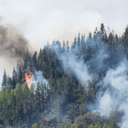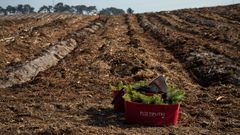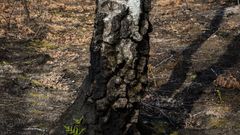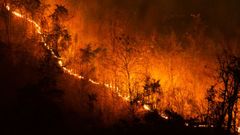
Helping burnt forests
Each company can play its part in restoring a burnt forest and rebuilding damaged ecosystems.

Would you like to get your company involved?
Would you like to get your company involved?
The massive forest fires in the summer of 2022 revealed the crucial lack of resources faced by many forest owners in reforesting after the fire.
To help them, EcoTree offers you the opportunity to support positive impact projects.
Your funding supports :
Our projects to restore burnt forests
Supporting forest owners in restoring their woods, an invaluable natural heritage. The following projects are in urgent need of funding.

Sarthe
2 ha à restaurer
3330 arbres à planter

Gironde
7 ha à restaurer
11660 arbres à planter

Alpes-de-Haute-Provence
10 ha à restaurer
16660 arbres à planter

Aude
7 ha à restaurer
11660 arbres à planter
What are you funding?
Situational analysis and project framing: making first diagnoses and forestry management plans, formalising contracts and fundraising
Site preparation: cleaning the plot, mulching the burnt wood and supporting soil restoration
Stand restoration: promoting natural regeneration or planting
Maintenance and monitoring: weeding during first three years, fill planting and information sharing
The French government supports the reforestation of French forests, and so does EcoTree
What impact do fires have on forest biodiversity?
Is forest biodiversity poorer after fire? At first sight, this would seem obvious, as all that remains at human level are charred trees and bushes. While some civilisations have used fire to enrich or amend soils before cultivating crops, these practices cannot be encouraged in a context of climate upheaval. It is currently difficult to say to what extent biodiversity is affected by forest fires, as it would be necessary to account in detail for the changes that occur in populations of insects, worms, nematodes, bacteria, micro-organisms, etc., and this depends on the richness of the ecosystem. Nevertheless, it can be said that forest fires, particularly when they are repeated, threaten the resilience of the existing ecosystem. It is therefore likely that it will not be able to recover without human help after such a violent shock. We also know that fires increase the risk of soil erosion and trigger physical and chemical degradation. All of this leads to the disappearance of some of the species present, favouring the establishment of those that are most resistant to fire, to the detriment of the most fragile, which may be the most interesting in terms of rich diversity.
What are the main causes of forest fires?
90% of forest fires are caused by humans, whether deliberately or not. Preventive measures can prevent a certain number of fires from starting, but above all we need to adapt our lifestyles to reduce the severity of droughts. Droughts are in fact a consequence of the climatic upheavals underway. Each and every one of us can pay attention to our daily water consumption and reduce our greenhouse gas emissions. The danger is that we are entering a positive feedback loop that feeds forest fires through drought, which is caused by global warming and our use of rainwater for intensive agriculture and leisure activities.
Climate change: a risk factor for fires?
The number of forest fires has been rising in recent years, and global warming is directly and indirectly responsible. Directly, because the heat dries out the water table, making trees more fragile and vegetation drier, and therefore more likely to start a fire. Indirectly, because global warming encourages the spread of pathogens such as bark beetles, which have killed a very large number of spruce trees in France, leaving behind dead trees that are highly flammable.
What preventive measures are in place to combat the risk of fire?
In France, there is a forest fire prevention plan prevention of forest fires, the rules of which are clearly laid down. During the summer, it is forbidden to smoke in a forest, or light a fire or barbecue within 200 metres of vegetation. Wild camping and parking vehicles in unauthorised areas are prohibited. Anyone living in a risk area is legally obliged to clear the undergrowth around their home. In addition, the civil security and fire brigades are trained in fire prevention and rapid response to any outbreak of fire. In this way, the combined efforts of government services and individuals help to prevent a number of fires. Unfortunately, there are also failings and malicious acts.
How do you select projects for funding?
We finance forests where silvicultural renewal has reached an impasse. We therefore only act at the request of the owners and after an expert or forest manager has judged that post-fire regeneration will be long and difficult and that human intervention will have a positive effect in the short, medium and long term on the damaged ecosystem.
With this in mind, EcoTree favours projects that are diversified (with a minimum of three different species); that include concrete commitments to biodiversity (freely evolving plots, senescence pacthes, opening or restoration of a wetland, installation of beehives and melliferous trees, etc.); that support natural regeneration and the development of new species; and that include a commitment to the protection of biodiversity.); that support natural regeneration; whose owners are committed to mixed forestry with continuous cover (affiliated to ProSilva or the Association Futaie Irrégulière network or adopting a management document along these lines).
How does your work play out on the ground?
Depending on the scenario, there are several possible scenarios for restoring a forest after a fire. In the first scenario, the plot is too badly damaged, so you have to start from scratch, in much the same way as in a clear-cut. The first step is to cut down the burnt trees, trying to make the best use of the wood. Then the ground is prepared by cleaning and other actions if necessary. Only then can we replant and put in place the usual management process: protection against game, clearing in the first few years, fill planting, partitioning and thinning cuts, and so on. In any case, reforestation should not be carried out in the season following the fire, as the root system may continue to burn below the surface. The fire is then said to be living. Allowing one or more years to pass will also allow the forest to regenerate naturally. Human intervention is only a last resort. In the second case, as was the case in Moustiers, our intervention consists of enriching a damaged ecosystem to strengthen its resilience through various actions. We start by carrying out a diagnosis, then draw up an inventory and qualify the trees to determine which ones we will retain for their ecological value. After that, we start by partially or totally clearing the existing partitions and tracks obstructed by charred wood, as well as determining the areas to be planted. These will be cleared (i.e. the trees are felled to make way for the plantations) before the plantations are planted and the young trees protected. The soil may also be scarified, removing an initial layer of burnt humus in the hope of encouraging natural regeneration. Finally, there are the actions of setting up enclosures or exclosures (non-screened delimited areas designed to protect, study and compare the evolution from one natural area to another on the same plot of land) around areas of natural regeneration and then all the usual stages in the management of a young forest.